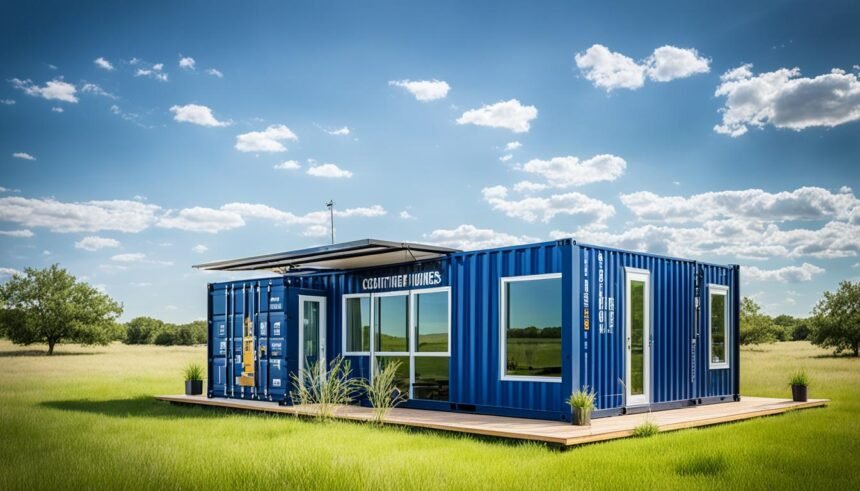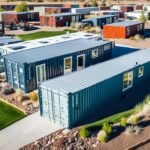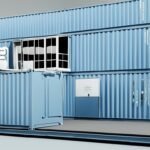Welcome to our comprehensive guide on container homes in Texas! If you’ve ever wondered about the legal aspects of building and living in container homes in the Lone Star State, you’ve come to the right place. In this article, we will explore the regulations, requirements, and laws that govern container homes in Texas. Let’s dive in!
Container homes have gained popularity as a cost-effective and sustainable housing option, and Texas is no exception. However, before embarking on your container home journey, it’s important to understand the legal framework surrounding these unique dwellings in the state.
Key Takeaways:
- Container homes are gaining popularity in Texas as a cost-effective and sustainable housing option.
- Understanding the legal requirements and regulations for container homes in Texas is crucial before starting a construction project.
- Zoning laws and permits play a significant role in determining where and how container homes can be built in Texas.
- Working with professionals who specialize in container homes can provide valuable guidance and ensure compliance with Texas laws.
- There are resources and support available for container home owners in Texas, including government agencies and online communities.
Understanding Zoning Laws
When it comes to building and living in container homes in Texas, it’s crucial to understand the zoning laws that apply. Zoning regulations help determine where and how different types of properties can be used within a particular area. These laws and regulations govern the land use, density, and overall development within specific zones, ensuring that the community operates in an organized and efficient manner.
For container home enthusiasts, understanding zoning laws is essential to ensure compliance and avoid potential legal issues. Zoning laws dictate which areas are suitable for residential, commercial, industrial, or mixed-use purposes. They may also specify minimum lot sizes, building setbacks, height restrictions, and other factors that can impact the construction and placement of container homes.
It’s important to note that zoning laws can vary from one city to another within the state of Texas. While some cities may have specific regulations and guidelines for container homes, others may not address them directly. In such cases, container homes may fall under existing regulations for residential housing or other similar structures.
Residential Zoning
In residential zones, container homes are typically subject to the same regulations as traditional residential dwellings. These zones are primarily intended for single-family homes, multifamily residences, or other types of residential properties. Depending on the specific zoning laws, container homes may need to meet certain requirements regarding setbacks, height limitations, aesthetics, and other factors.
Mixed-Use Zoning
In certain areas designated as mixed-use zones, container homes may enjoy more flexibility in terms of land use. Mixed-use zones are intended to accommodate a combination of residential and commercial activities. This can create opportunities for container homes to be used as both living spaces and home-based businesses, subject to the zoning regulations and any additional requirements set forth by the local authorities.
Understanding the zoning laws for container homes in Texas is crucial to navigate the regulatory landscape and ensure compliance with local regulations. By familiarizing yourself with the zoning laws that apply in your specific area, you can plan and build your container home with confidence.
To get a better understanding of the zoning laws in your city or county, you can consult with the local planning department or zoning board. They can provide information on the specific zoning regulations that apply to container homes and provide guidance on any additional requirements or permits that may be necessary.
As container homes continue to gain popularity as a sustainable and innovative housing solution, some areas in Texas have embraced their potential. Certain cities and counties have even implemented specific zoning ordinances to accommodate and regulate container homes. These ordinances may outline specific design standards, energy efficiency requirements, and other guidelines tailored to container home construction.
It’s important to stay informed about any updates or changes to zoning laws, as they can evolve over time. Regularly checking official websites or consulting with local authorities will ensure that you have the most up-to-date information regarding zoning laws for container homes in Texas.
| Zoning Category | Key Restrictions |
|---|---|
| Residential | – Minimum lot size – Building setbacks – Height limitations – Aesthetics |
| Mixed-Use | – Flexible land use – Residential and commercial activities – Additional requirements may apply |
Permits and Regulations
When it comes to building and living in container homes in Texas, understanding the permits and regulations is crucial. To ensure a smooth process, it’s important to be aware of the specific permits that may be necessary and the building codes that must be followed.
Permits for Container Homes in Texas:
Before embarking on your container home project, it’s essential to determine the permits required by local authorities. These permits may vary depending on the location and size of your container home. Generally, you may need permits for:
- Construction: Obtaining a construction permit ensures that your container home meets all safety standards and regulations.
- Electrical: This permit is necessary if you plan to install or modify electrical systems in your container home.
- Plumbing: If you intend to have plumbing fixtures or make modifications to your container home’s plumbing system, a plumbing permit will be required.
- Zoning: Zoning permits are essential to ensure that your container home complies with the specific regulations and restrictions set by local zoning ordinances.
It’s important to consult with your local building department or relevant authorities to determine the exact permits required for your container home project. By obtaining the necessary permits, you can ensure that your construction process is legal and compliant with local regulations.
Container Home Building Codes in Texas:
Building codes play a vital role in ensuring the safety and structural integrity of container homes. The specific building codes applicable to container homes in Texas may depend on factors such as the geographical location and the size of the dwelling.
Local building codes typically cover various aspects of construction, including:
- Foundation: The code requirements for the foundation of a container home ensure stability and durability.
- Structural Integrity: These codes ensure that the building structure can withstand external factors such as wind, earthquakes, and other forces.
- Electrical and Plumbing Systems: Building codes also govern the installation and safety of the electrical and plumbing systems within container homes.
- Insulation and Ventilation: Codes related to insulation and ventilation ensure energy efficiency, comfort, and proper airflow within container homes.
Consulting with a professional architect or contractor experienced in container home construction can help ensure that your project adheres to the relevant building codes in Texas. By following the designated codes, you can create a safe and compliant container home.
Remember, each city or county within Texas may have specific regulations and codes, so it’s crucial to research and understand the requirements in your specific area.
Building Codes Comparison: Texas vs. Other States
| State | Container Home Building Codes |
|---|---|
| Texas | Specific building codes applicable to container homes must be followed, taking into account factors such as foundation, structural integrity, electrical and plumbing systems, and insulation and ventilation. |
| California | California has embraced container homes and has specific guidelines for their construction. These guidelines cover building codes related to materials, insulation, fire safety, and structural integrity. |
| Florida | Florida follows the International Residential Code (IRC), which outlines the requirements for container homes. These codes cover aspects such as wind resistance, insulation, structural integrity, and water resistance. |
| Colorado | Colorado follows the International Building Code (IBC) for container homes. These codes emphasize structural integrity, fire safety, and insulation requirements. |
As seen in the comparison table, each state has its own set of building codes applicable to container homes. Therefore, it’s important to research and adhere to the specific regulations and codes in your state to ensure a successful container home project.
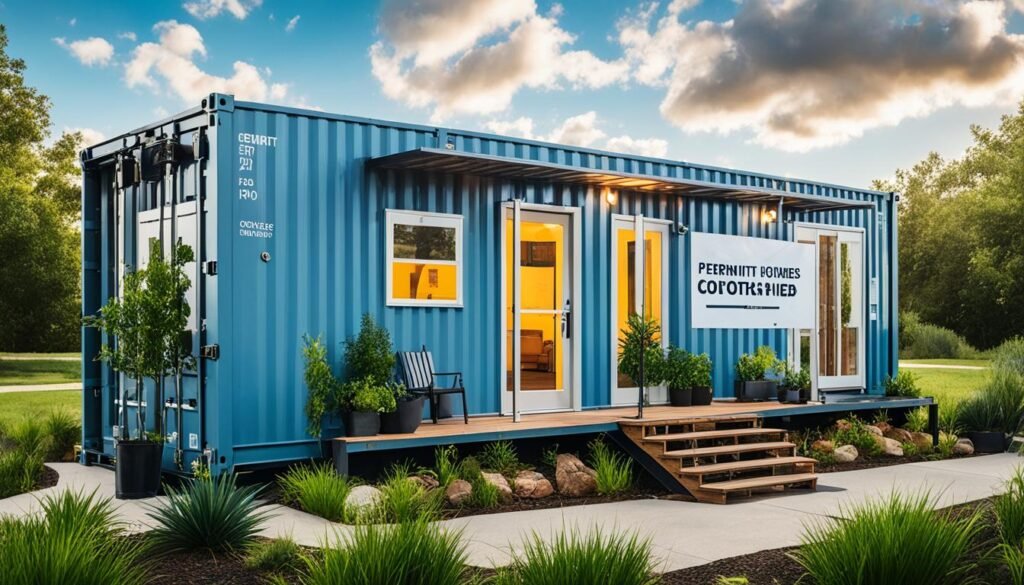
Sustainable Housing Options in Texas
When it comes to sustainable housing options in Texas, container homes offer a unique and environmentally friendly solution. These homes are not only innovative in design, but they also have a minimal environmental footprint.
Container homes utilize repurposed shipping containers, giving new life to these sturdy structures. By using recycled materials, container homes help reduce the demand for new construction materials, which in turn reduces waste and energy consumption.
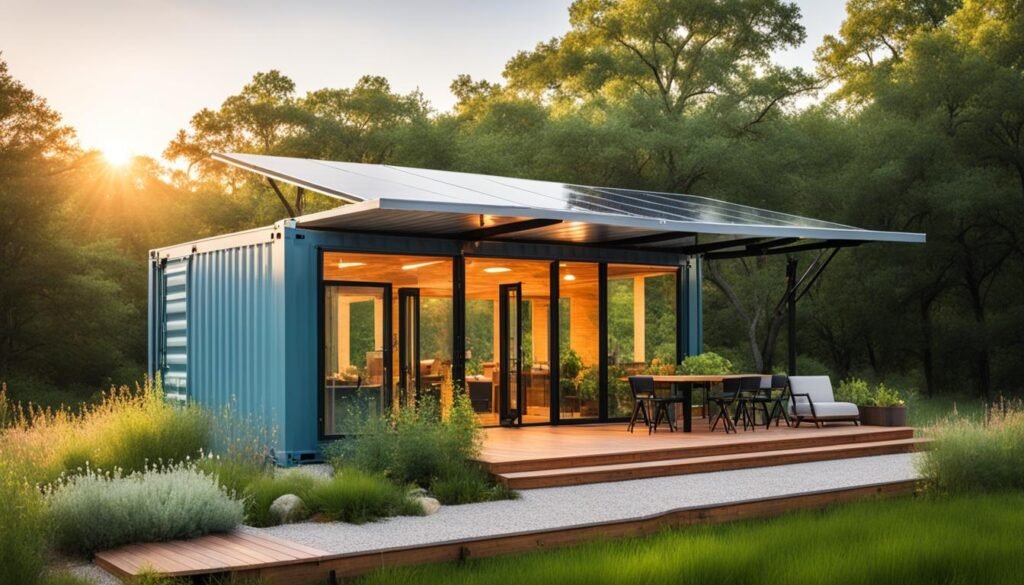
Container homes also have the advantage of being highly energy-efficient. The structural integrity of the shipping container provides excellent insulation properties, making it easier to maintain a comfortable indoor temperature year-round. This translates to lower energy bills and reduced dependence on heating and cooling systems.
Furthermore, container homes can incorporate sustainable features such as rainwater harvesting systems, solar panels, and green roofs. These eco-friendly additions further enhance the sustainability of these homes, reducing water and energy consumption while promoting a greener lifestyle.
The Benefits of Container Homes in Texas:
- Reduced environmental impact through the use of repurposed materials
- Energy efficiency and lower utility costs
- Potential for incorporating sustainable features
- Flexibility in design and customization
- Shorter construction time compared to traditional homes
“Container homes offer a sustainable and affordable housing option that allows individuals in Texas to reduce their carbon footprint while enjoying the benefits of a unique and modern living space.”
Recognizing the importance of sustainable housing, Texas has undertaken various initiatives and incentives to promote environmentally friendly homes. These include tax incentives, grants, and programs that support eco-friendly construction practices.
| Initiative/Incentive | Description |
|---|---|
| Texas Green Building Program | A voluntary program that promotes the construction of energy-efficient and sustainable homes, offering recognition and incentives for environmentally friendly building practices. |
| Texas Property Assessed Clean Energy (PACE) Program | A financing program that allows property owners to obtain low-cost, long-term loans for energy-efficient upgrades to their homes, including the installation of solar panels and other sustainable features. |
| Property Tax Exemptions | Texas law allows for property tax exemptions on the appraised value of residential properties equipped with solar or wind energy devices. |
These initiatives not only encourage sustainable housing practices but also make it more financially viable for individuals to embrace eco-friendly alternatives like container homes.
Container homes offer a sustainable and affordable housing option that allows individuals in Texas to reduce their carbon footprint while enjoying the benefits of a unique and modern living space. With the support of government initiatives and incentives, sustainable housing in Texas is becoming more accessible and appealing to those who value sustainability and innovation.
Advantages and Disadvantages of Container Homes in Texas
Container homes have gained popularity in Texas for their unique design, sustainability, and affordability. However, like any housing option, container homes come with their own advantages and disadvantages. It’s essential to consider these factors before making a decision.
Advantages of Container Homes in Texas
- Cost-effectiveness: Container homes are typically more affordable compared to traditional houses, making them an attractive option for budget-conscious individuals.
- Durability: Shipping containers are built to withstand harsh conditions, making container homes highly durable and resistant to natural disasters.
- Versatility: Container homes offer flexible design possibilities, allowing homeowners to create unique and customizable living spaces that suit their needs and preferences.
- Sustainability: Repurposing shipping containers reduces waste and helps conserve natural resources, making container homes a sustainable housing option in Texas.
Disadvantages of Container Homes in Texas
- Space Limitations: Container homes are typically smaller in size compared to traditional houses, which may limit living space, especially for larger families or individuals with extensive belongings.
- Insulation Challenges: Proper insulation is crucial for container homes to ensure comfort in varying weather conditions. Without proper insulation, container homes may experience temperature extremes.
- Permitting and Zoning Issues: Depending on the location, obtaining permits and navigating zoning regulations for container homes in Texas can be challenging and time-consuming.
- Design Limitations: While container homes offer design flexibility, the structural limitations of shipping containers may restrict certain architectural features and design options.
“Container homes offer cost-effective and sustainable housing solutions in Texas. However, it’s important to consider the limitations, such as space constraints and insulation challenges, before embracing this alternative living option.”
In the next section, we will explore real-life case studies of container home projects in Texas, showcasing the diverse possibilities and experiences within the container home community.
Case Studies of Container Home Projects in Texas
Real-life examples of container home projects in Texas provide invaluable insights into the possibilities and realities of this unique housing concept. From innovative designs to sustainable living, these case studies showcase the diverse range of container homes that have been successfully built and inhabited in the Lone Star State.
Example 1: The Austin Retreat
“Our container home in Austin is the perfect blend of modern aesthetics and eco-friendliness,” says Jane Anderson, owner of a stunning container home nestled in the heart of the city. The two-story home features an open-plan layout, with floor-to-ceiling windows that bring in abundant natural light. To maximize energy efficiency, Anderson incorporated solar panels and rainwater harvesting systems. The Austin Retreat is a testament to the versatility and sustainability of container homes in urban environments.
Example 2: The Hill Country Haven
“Living in a container home has allowed us to enjoy the tranquility of the Texas Hill Country while minimizing our environmental footprint,” shares Mark Johnson, owner of the Hill Country Haven. Located in the scenic countryside near Fredericksburg, this container home offers breathtaking views of rolling hills and vineyards. Johnson’s home features a spacious deck, perfect for enjoying the sunsets, as well as an innovative green roof that helps regulate indoor temperatures. The Hill Country Haven exemplifies the harmonious integration of a container home with its natural surroundings.
Example 3: The Coastal Retreat
“Our container home on the Texas coast is a testament to resilience and sustainability,” enthuses Sarah Martinez, owner of the Coastal Retreat. Situated in a coastal community, Martinez’s home is designed to withstand hurricanes and extreme weather conditions. The container home incorporates reinforced steel structures, impact-resistant windows, and elevated foundations. Beyond its durability, the Coastal Retreat offers panoramic views of the Gulf of Mexico and the opportunity for sustainable beachfront living.
These case studies demonstrate that container homes in Texas can be customized to suit various styles, locations, and individual preferences. From vibrant urban settings to picturesque countryside and coastal areas, container homes offer a unique and sustainable housing solution for those seeking an alternative to traditional dwellings.
| Case Study | Location | Design Features | Key Highlights |
|---|---|---|---|
| The Austin Retreat | Austin | – Modern aesthetics – Solar panels and rainwater harvesting systems – Open-plan layout |
– Blend of modern design and sustainability – Urban container home |
| The Hill Country Haven | Fredericksburg | – Scenic countryside location – Green roof and spacious deck – Breathtaking views |
– Integration with natural surroundings – Sustainable living in the Texas Hill Country |
| The Coastal Retreat | Coastal community | – Hurricane-resistant design – Steel structures and impact-resistant windows – Elevated foundations |
– Resilience in coastal environments – Panoramic Gulf views |
These case studies inspire and inform individuals interested in container homes, offering tangible examples of the possibilities and advantages they bring. By showcasing the diverse range of container home projects in Texas, we hope to inspire readers to explore this innovative housing option and embark on their own container home journey.
Working with Professionals in Texas
When it comes to building your dream container home in Texas, working with experienced professionals is crucial to ensure your vision becomes a reality. Architects, builders, and contractors specializing in container homes can offer invaluable expertise and guidance throughout the design and construction process.
Finding the Right Professionals
Begin by researching professionals who have specific experience with container homes in Texas. Look for architects who have successfully designed container homes that meet the requirements of the local zoning laws and building codes.
Builders and contractors with a proven track record in constructing container homes can provide reliable construction services. They are familiar with the unique challenges and considerations of working with shipping containers, ensuring a smoother and more efficient building process.
Collaborating on Your Design
Working closely with professionals is essential to translate your ideas into a well-designed container home. Share your vision, requirements, and preferences with the architect, allowing them to create a custom plan that suits your needs.
During the construction phase, collaborate closely with your builder or contractor to ensure the project stays on track. Regular communication and site visits provide an opportunity to address any questions or concerns, ensuring your container home is built to your specifications.
Requesting References
When vetting professionals, don’t hesitate to request references from their previous container home projects. Reach out to past clients and ask about their experience working with the professional in question. Their feedback can provide valuable insights to help you make an informed decision.
“Working with a professional who understood the unique challenges of container home construction made all the difference. They guided us through the process, ensuring our container home turned out exactly how we envisioned it.”
– John and Sarah, proud container home owners in Texas
Ensuring Compliance with Regulations
Professionals with experience in container home construction in Texas are well-versed in local regulations and building codes. They understand the specific requirements that container homes must meet and can navigate the necessary permits and inspections on your behalf.
By partnering with professionals who have expertise in container homes, you can have peace of mind knowing that your project is in capable hands. They will ensure that all legal, structural, and design aspects are handled professionally to create a container home that meets your expectations.
Continue reading for a list of resources and support available for container home owners in Texas.
Resources and Support for Container Home Owners in Texas
As a container home owner in Texas, there are various resources and support available to assist you in navigating the unique challenges and opportunities of this housing option. Whether you need guidance on permits and regulations or want to connect with like-minded individuals, these resources will prove invaluable in your container home journey.
Government Agencies
Several government agencies in Texas provide information and support specifically tailored to container home owners. These agencies can help you understand the legal requirements, permits, and building codes that apply to your container home project. Some key government agencies to contact include:
- Texas Department of Licensing and Regulation
- Texas Department of Housing and Community Affairs
- Texas State Energy Conservation Office
Organizations
There are organizations dedicated to promoting sustainable and innovative housing solutions, including container homes, in Texas. These organizations offer resources, workshops, and events that can enhance your knowledge and provide networking opportunities. Consider reaching out to:
- Texas Association of Builders
- Texas Society of Architects
- Texas Green Building Council
Online Communities
Connecting with fellow container home enthusiasts through online communities can offer invaluable support, advice, and inspiration. These communities provide a platform for sharing experiences, discussing challenges, and getting recommendations from others who have gone through the container home journey. Some popular online communities for container home owners in Texas are:
- Texas Container Homes Forum
- Container Home Owners Texas Facebook Group
- Container Home Living Texas Community
By utilizing these resources and connecting with others in the container home community, you can gain valuable insights, support, and knowledge that will enhance your container home experience in Texas. Remember, every journey is unique, and these resources can help you make your container home a comfortable, legal, and sustainable living space.
Conclusion
In conclusion, container homes provide a legal and sustainable housing option for individuals in Texas who are looking for unique and eco-friendly housing solutions. By understanding the zoning laws that apply to container homes, prospective homeowners can determine the areas where they can build and live in these innovative structures.
To ensure compliance with regulations, it is crucial to obtain the necessary permits and adhere to building codes specific to container homes in Texas. This helps in creating a safe and durable living environment while also respecting legal requirements.
Working with professionals experienced in container home construction can provide invaluable guidance and expertise throughout the project. Architects, builders, and contractors who specialize in these unique dwellings can help bring your vision to life while ensuring all legal aspects and best practices are met.
As container homes continue to gain popularity, Texas offers a range of resources and support for container home owners. From government agencies that provide information and guidance to online communities that offer a platform for sharing experiences, there is a wealth of support available to help individuals navigate the process of owning and living in a container home in Texas.

